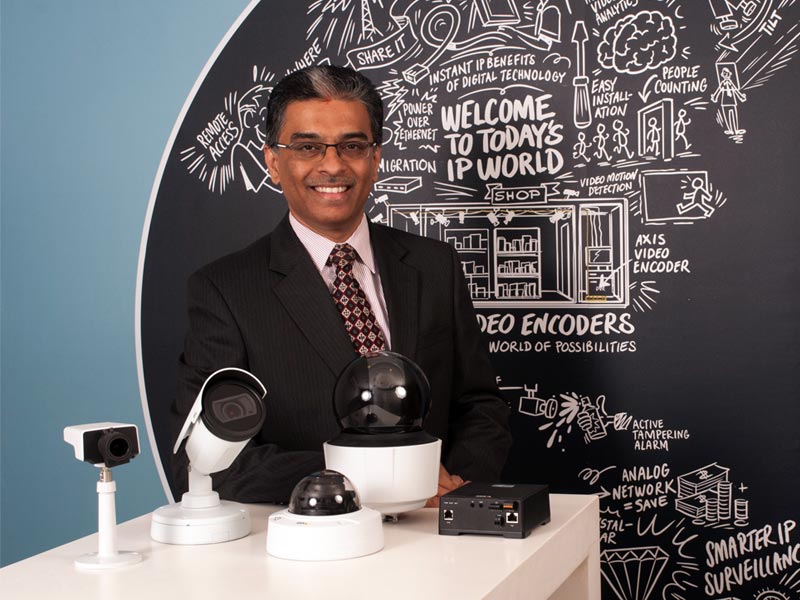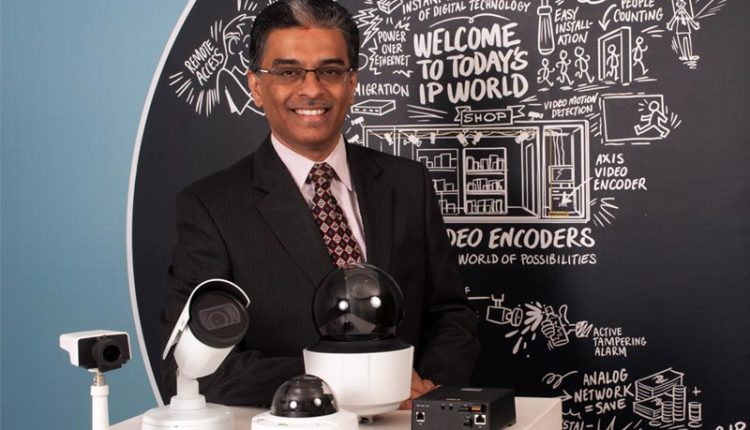Surveillance is important pieces of the smart cities ecosystem in India

Swedish security solutions company, Axis Communications, is eyeing huge growth prospects in India in the wake of Government’s Smart Cities project. In an extensive interview with ISR, Sudhindra Holla, Sales Director – India & SAARC, Axis Communications says that India is standing on the cusp of a major opportunity and security vendors just need to focus in the right direction to capitalize on this opportunity. He talks about the technology trends emerging in surveillance, key segments driving the growth and the company’s vision and growth plans. Excerpts
Surveillance market has been witnessing a lot of traction. In your view, what are the key factors driving the growth?
Surveillance market has been on a strong growth trajectory over the last few years and will continue its upward trend. This growth is due to a mix of a lot of things. Most important, of course, is the safety element—there is definitely increased general awareness on safety. We can see surveillance being increasingly used in public places to bring down crime, enhance women safety, etc. Secondly, government push on safety with initiatives, such as smart cities and mandatory safety regulations are also spurring the demand.
Apart from safety, the usage of surveillance systems in verticals, such as retail is also driven by the need to tap into the business potential of BI. For instance, retailers are using surveillance systems to gather data and gain actionable insights on key business decisions like how to improve customer satisfaction or optimize the stores.
Comment on the most significant technology trends influencing the surveillance market.
One of the trends that we are witnessing, strictly speaking in terms of camera, is that the technology is getting extremely powerful. In the last two-three years, there has been a remarkable improvement in picture quality and evidence-grade video even in difficult or low light conditions.Usage of thermal cameras is on the rise. In low-light areas or even pitch-dark areas, thermal camera provides reliable detection as it creates images based on heat generated from any object, vehicle or person.
We are also increasingly seeing an integration of lot of technologies so that all the different sensors come together and give a number of functionalities from a single unit to the customers. To give you an example, network audio is being integrated with video, which enables customers to make a live announcement or schedule announcements from the same system. This kind of integration gives a complete package to the customers.
Then, of course, there is a big trend of big data and analytics across industries, and surveillance is no exception. We can see a heightened interest on how to make sense of various video footages captured by different cameras and how to stitch together the incidents on different cameras to derive insights. So, there is a lot of activity happening on the analytics front.
Another trend that is fast picking up is cyber security in the context of video surveillance. Customers are realizing that a camera getting hacked is not just hacking of the video footage but a serious security breach. With integration of so many technologies in the surveillance systems, any vulnerability in the system is like someone breaking your front door. Organizations are coming to terms with this reality and are taking a proactive approach in addressing the risks.
According to you, how important is the role of security surveillance systems in attaining government’s Smart Cities Vision.
What makes a city smart? I believe that becoming a safe city, is the first step for a city to become a smart city. The Government of India’s Smart Cities Mission,with an estimated budget of ₹2.09 lakh crore focus on infrastructure and services taken to promote intelligent solutions. The project is aimed at taking existing areas and applying ‘smart’ thinking to improve them, through retrofitting and redevelopment. These smart city projects will lead to an improved quality of life for citizens. Surveillance is one of the most relevant and important pieces of the smart cities ecosystem in India.
Surveillance systems can definitely help increase crime investigation efficiency and in turn bring down the crime rate in a city. While safety is an obvious advantage of video surveillance systems, they also havegreat potential in providing more advanced public services, such as traffic management and control, energy management, waste management, water management, to name a few.
What would be the major verticals you’ll be concentrating on in 2018?
We have always been very strong in the large corporate and IT segment and we will continue to focus on that. We are also sensing huge opportunities in the education and manufacturing sector and feel that we can take our solutions to the next level with these high-growth segments. Then, of course, there are smart cities, which is a huge focus area for us at Axis. Apart from that, retail and hospitality are also showing high growth potential.
How do you perceive India as a market, what are the opportunities and challenges?
Market in India is, no doubt, challenging. However, at the same time it has opportunities too. I feel, we need to find the correct balance between the challenges and opportunities to reap the optimal results. If we look at the World Bank’s Ease of Doing Business global rankings, India has moved up to 100th spot from its last year’s 130th rank. Indian market is growing at a very healthy rate. As per the findings of a report by IHS, India’s market for network video camera is growing at a CAGR of 16% to reach 258 million in 2022 from the current 158 million. So, definitely opportunities are galore and for vendors like us it’s all about focusing in the right direction to capitalize on the opportunity. India is definitely a key market for Axis’s Asia Pacific operations that currently contributes about 12% of global revenues.
Please update us on key projects that you have undertaken for the Indian government.
As part of our focus on smart cities, we have bagged six big projects—Hyderabad, Bhavnagar, Junagadh, Kolhapur, Nanded City and Aurangabad. Each city has different requirements and through the support of our partners, we have successfully implemented our solutions. For example, in Bhavnagar, we installed IP66-rated cameras as they needed a traffic monitoring system. In Kolhapur, all the tourist attractions and city entry/exit points had to be monitored, for which we deployed 165 network cameras at 65 locations. The Hyderabad Smart City project is an example of community participation towards building a safer and secured smart city. We have 1,500 camera installations across the city to track, monitor and analyze the video feed for detecting criminal activities, traffic violations, and road conditions.
Companies are excited about new technologies like Big Data, IoT and AI. How is Axis planning to cash in on these disruptive tech trends?
At Axis, we have evolved from a camera-centric approach by constantly adopting to newer technologies and catering to the changing market needs. IoT is crucial in a scalable architecture to manage the network of connected devices, scale and analyses effectively. With IP-based security devices increasingly replacing analog systems, we predict wider use of security products that will integrate with the data generated by IoT connected devices for enhanced security surveillance applications and uses.
The AI integration in future will allow network cameras to think independently and make smart decisions. For example, smart city applications are now based on linking data from various sources and then making sense of it, like collecting traffic related data such as vehicle counts, average speed per traffic lane, traffic lane occupancy, vehicle classification, etc. In future, with extended camera capabilities, they will be able to gather people and crowd related data including people counting, crowd capacity, etc.
While the industry uses machine or deep learning mostly for video analytics, we believe technological innovation in AI, Big Data and IoT will play a much greater role in different applications. We are conscious about the deep learning and think it needs to be more mature.
What is your vision and growth plan for the company?
Our focus will continue to be on building stronger channel ecosystem to meet the needs of our end customers. We have initiatives to grow our active channel and solution partner base.Another aspect of our strategy includes trying to win big in government, safe cities and smart cities projects. We incorporate our segment approach by making investments in Business Development Managers. Further, we plan to introduce more innovative products and solutions based on market feedback and requirement.

